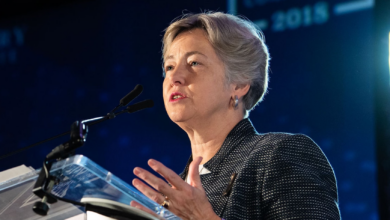By DUNCAN ADAMS
The Roanoke Times
LEXINGTON, Va. – T.J. Fisher felt like a novelty.
“I was out in high school, but it was more like I was out in theory because I didn’t have any community to connect to,” Fisher said.
Now, the gay 17-year-old freshman at Washington and Lee University has found community at this small, private, liberal arts university once considered markedly homophobic.
“Party of one? Not anymore,” he said.
Fisher, from Potomac, Md., estimates he spends 10 hours a week at the school’s resource center for gay, lesbian, bisexual, transgender and questioning students.
The GLBTQ center opened in September on the second floor of a small house on campus. It features a lounge with a large, flat-panel TV, Oriental rug, comfortable, stylish furnishings, a meeting room and a bathroom.
And its existence is seen by many students, faculty and alumni as a sign that W&L’s embrace of diversity has traveled a long way in a short time and is catching up to some larger universities in the state. (The University of Virginia’s LGBT resource center celebrated its 10th anniversary in November.)
“Having the resource center on campus shows, in a very visible way, that the school is supporting the GLBT community,” said Dave Perry-Miller, class of 1980, a successful businessman in Dallas and a donor to both the university and the resource center.
Perry-Miller said that he came close to transferring from W&L during his sophomore year because he was at a crossroads about his sexual orientation and feeling as though the school promised nothing but “intense heartbreak,” marginalization and stigmatization.
Just four years ago, W&L ranked ninth on Princeton Review’s list of schools that were “LGBT-Unfriendly.” In 2003, it ranked second. (In recent years, W&L has opted out of participating in the review’s rankings on a host of measures.)
Times have changed, according to Fisher and four other students interviewed last month at the resource center in Hill House.
“It’s not, by any means, a homophobic school like it might have been a few decades ago,” said Chris Washnock, a 22-year-old senior from Greenville, S.C.
“I think W&L has changed a lot just in the last four years,” he said.
As it turned out, Fisher met Washnock before choosing to enroll at W&L. The admissions office put the two in touch after Fisher said he wanted to interview a male student about his experiences of the campus climate for gay men before making a decision.
“They sent me to Chris,” Fisher said. “I wouldn’t be here if it wasn’t for him.”
Washnock clearly celebrates W&L for reasons that go beyond a growing tolerance for issues of sexual orientation- for its honor system, for its academics, for its traditions, civility and more.
“It’s a classy place,” Washnock said.
He acknowledges that residual homophobia lingers in some quarters.
“There are still a few Greek organizations where it’s not possible to be an out gay person,” Washnock said.
But change has come also to many fraternities and sororities, said he, Fisher and law student Roddy Flynn, 26, of Wilmington, Del.
Many fraternities seeking new members don’t care about sexual orientation and “evaluate you on other merits,” Flynn said.
And, of course, there is gender and lifestyle diversity even among the students who use the resource center.
Meghan Ingram, a 21-year-old senior from Greensboro, N.C., said it provides an especially comfortable and comforting setting for her.
“I feel that here, more than anyplace on campus, I can be myself,” Ingram said.
She estimates spending more than 10 hours a week at the center.
De-Anna Clarke is 20 years old and a junior from Atlanta. She said she believes one reason there is more acceptance now of GLBTQ students at W&L is that college students today are more apt to embrace diversity than previous generations.
Members of W&L’s administration, staff and faculty, and President Kenneth Ruscio have supported reaching out to the GLBTQ community, said Washnock, Perry-Miller and Beth Curry, a counselor at the University Counseling Center.
Perry-Miller said the administration contacted him about helping to pay to outfit the resource center. A year before the center opened, a student at Rutgers University had committed suicide after a roommate allegedly streamed images online of the student having an intimate encounter with another man.
Perry-Miller said he thought about the Rutgers student before he cut the check for the center, thereby creating, he hoped, a safe place “to talk to people about issues they might feel uncomfortable talking about anywhere else.”
W&L first enrolled women in undergraduate classes in 1985.
Perry-Miller said it makes sense for the private university to broaden efforts to recruit. Fall enrollment at W&L is 2,198, including 1,795 undergraduate and 403 law.
He referenced the school’s motto: “not unmindful of the future.”
Washnock said some of the older alumni who have visited the resource center apparently experienced a sense of catharsis, moved by how much has changed since the days when gay men avoided persecution by staying in the closet.
One visitor was 96 years old, he said.










